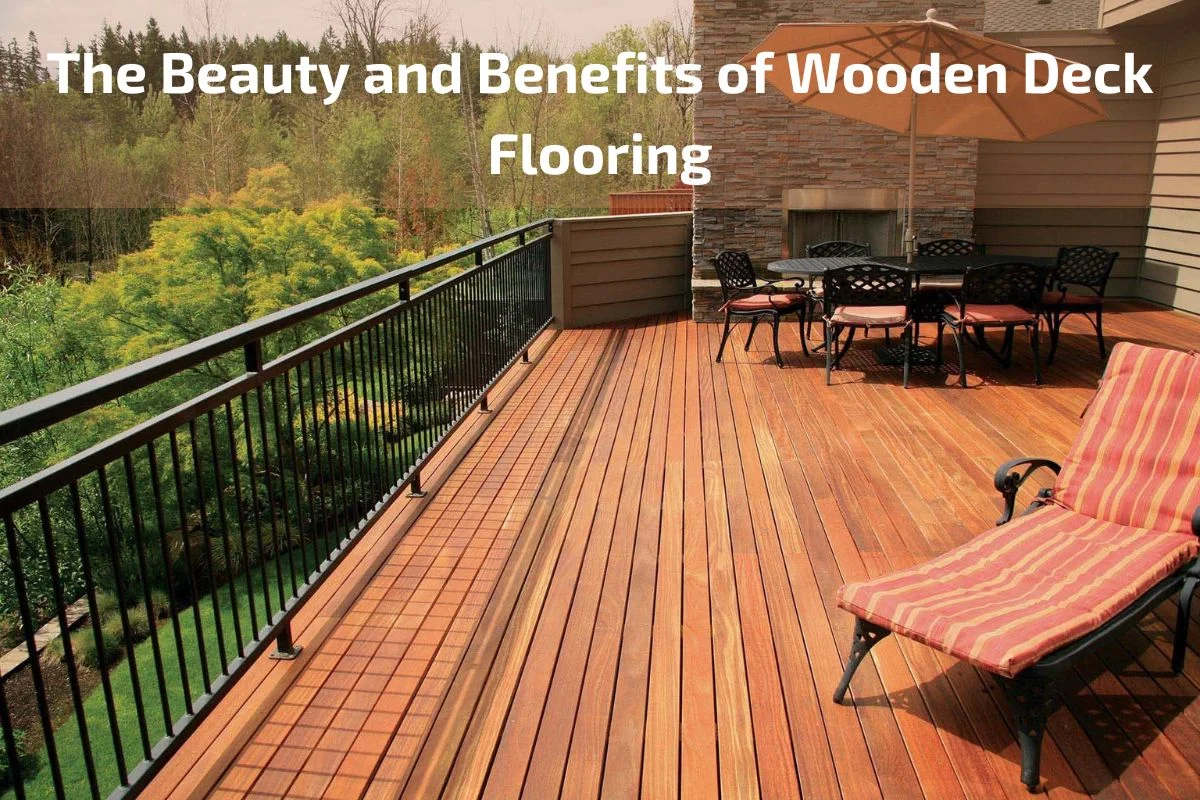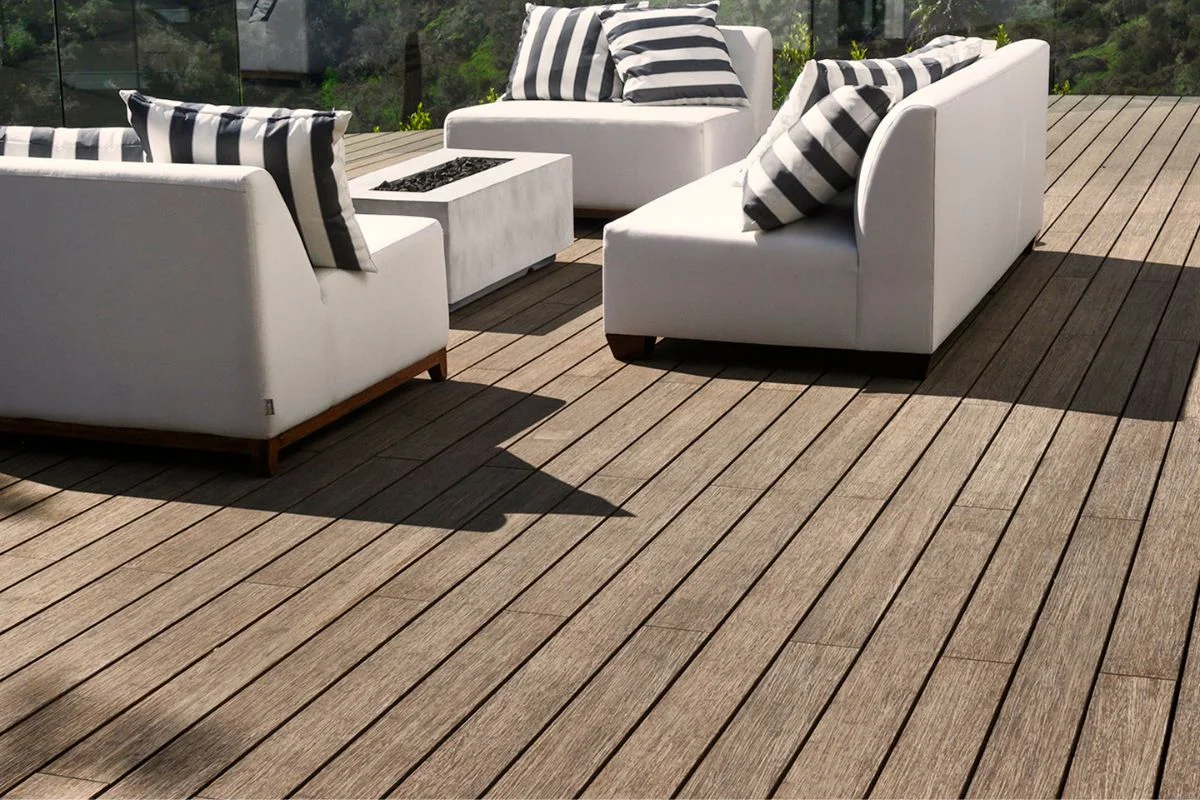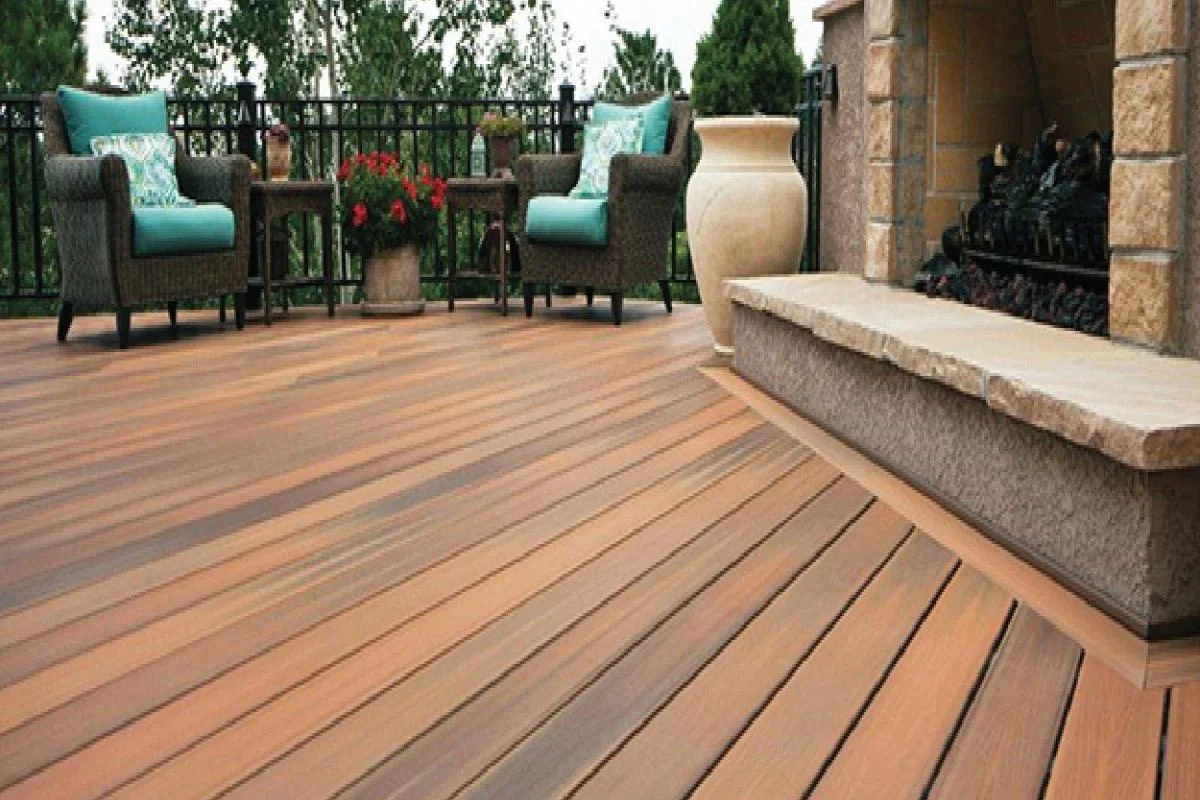
Wooden deck flooring exudes natural beauty and timeless charm, making it a popular choice for outdoor spaces. Whether surrounding a pool, gracing a backyard patio, or providing an inviting space for outdoor gatherings, wooden deck flooring offers a range of benefits that enhance the functionality and aesthetics of any outdoor area.
In this article, we’ll explore the beauty and benefits of wooden deck flooring, delving into its unique characteristics, versatile design options, and practical advantages. From its warm, organic appeal to its durability and sustainability, wooden deck flooring has much to offer homeowners seeking to create inviting outdoor retreats that seamlessly blend with nature.
Join us as we journey through the world of wooden deck flooring, uncovering its inherent beauty, exploring its many advantages, and gaining insights into how it can transform outdoor spaces into havens of relaxation, entertainment, and natural splendor.
Brief overview of wooden deck flooring
Wooden deck flooring is a popular choice for outdoor spaces, offering a blend of natural beauty, durability, and versatility. It involves the installation of wooden planks or tiles over a supporting structure to create a functional and visually appealing surface for relaxation, entertaining, and outdoor activities. Wooden decks come in various wood species, each with its own unique characteristics and aesthetics, ranging from the warm tones of cedar to the exotic appeal of tropical hardwoods. They enhance outdoor environments by adding warmth, charm, and a connection to nature, making them ideal for residential patios, decks, balconies, and commercial spaces. With proper maintenance and care, wooden deck flooring can withstand the elements and provide years of enjoyment in outdoor living.
Importance of wooden decks in outdoor spaces
Wooden decks play a crucial role in enhancing outdoor spaces and are valued for several reasons:
Aesthetic Appeal: Wooden decks add natural warmth and charm to outdoor environments, creating inviting areas for relaxation, socializing, and entertainment. Their rich textures and varied grain patterns complement landscaping and architectural features, enhancing the overall visual appeal of the space.
Extension of Living Space: Wooden decks effectively extend the usable living area of a home into the outdoors, providing additional space for dining, lounging, and recreation. They serve as transitional zones between indoor and outdoor areas, blurring the boundaries and encouraging seamless integration with nature.
Versatility: Wooden decks offer versatility in design, allowing for customization to suit different preferences, architectural styles, and functional requirements. They can be tailored to accommodate various layouts, sizes, shapes, and elevation changes, providing flexibility in creating personalized outdoor living environments.
Functional Use: Wooden decks serve as practical platforms for a wide range of outdoor activities, from hosting gatherings and barbecues to enjoying morning coffee or simply soaking up the sun. They provide stable, comfortable surfaces for furniture, grills, planters, and other outdoor amenities, enhancing usability and convenience.
Value Addition: Well-designed and maintained wooden decks can increase the market value and curb appeal of a property, making it more attractive to potential buyers or renters. They represent desirable features that enhance the overall appeal and perceived value of the outdoor living space.
Connection to Nature: Wooden decks create a direct connection to the natural environment, allowing occupants to immerse themselves in outdoor surroundings while still enjoying the comfort and convenience of home. They offer opportunities to enjoy fresh air, sunshine, and scenic views, promoting relaxation, stress reduction, and overall well-being.
Customization: Wooden decks can be customized with various features and amenities to meet specific lifestyle needs and preferences. From built-in seating and planters to pergolas and fire pits, there are endless possibilities for enhancing functionality and personalizing the outdoor experience.
The Beauty of Wooden Deck Flooring
The beauty of wooden deck flooring is unparalleled, adding a natural warmth and charm to outdoor spaces that is difficult to replicate with other materials. Here’s a closer look at what makes wooden deck flooring so visually appealing:
Natural Aesthetics: One of the most striking features of wooden deck flooring is its natural beauty. Each piece of wood carries its own unique grain pattern, texture, and color variations, creating a visually captivating surface that adds character and depth to outdoor environments.
Warmth and Elegance: Wooden decks exude a sense of warmth and elegance that is inviting and comforting. The earthy tones of wood complement a variety of architectural styles and landscaping elements, seamlessly blending with the natural surroundings.
Timeless Appeal: Wooden deck flooring has a timeless quality that transcends trends and fads. Whether it’s a classic cedar deck or a richly stained tropical hardwood, the timeless appeal of wood never goes out of style, making it a lasting investment in the aesthetic value of outdoor spaces.
Enhanced by Aging: As wooden decks age, they develop a unique patina and character that further enhances their beauty. Weathering, fading, and subtle changes in texture add to the rustic charm of wooden deck flooring, telling the story of years spent basking in the elements.
Complementary to Greenery: Wooden decks provide a natural backdrop that complements lush greenery, blooming flowers, and other landscaping features. The organic beauty of wood harmonizes with the colors and textures of the surrounding vegetation, creating a cohesive and visually pleasing outdoor oasis.
Versatile Design Options: From traditional hardwoods like cedar and redwood to exotic species like Ipe and Cumaru, wooden deck flooring offers a wide range of design options to suit different tastes and preferences. Whether you prefer a classic, understated look or a bold, statement-making design, there’s a wood species to match your vision.
Types of Wood for Decking
When it comes to decking, the choice of wood species plays a significant role in determining the aesthetics, durability, and overall performance of the deck. Here are some common types of wood used for decking:
Pressure-Treated Wood:
- Description: Pressure-treated wood, typically Southern Yellow Pine, undergoes a process where preservatives are forced into the wood under pressure, enhancing its resistance to rot, decay, and insect damage.
- Advantages: Pressure-treated wood is readily available, affordable, and easy to work with. It offers decent durability and can be stained or painted to match different styles.
- Disadvantages: It requires regular maintenance, such as sealing and staining, to prolong its lifespan. The chemicals used in the treatment process may raise environmental concerns.
Cedar:
- Description: Cedar is a naturally durable softwood known for its resistance to rot, decay, and insect damage. It features a warm reddish-brown hue with natural variations in grain pattern.
- Advantages: Cedar decking offers natural beauty, durability, and a pleasant aroma. It requires less maintenance compared to pressure-treated wood and is naturally resistant to decay.
- Disadvantages: Cedar is typically more expensive than pressure-treated wood and may still require periodic maintenance to preserve its appearance and structural integrity.
Redwood:
- Description: Redwood is another naturally durable softwood species prized for its rich reddish-brown color and resistance to decay and insects.
- Advantages: Redwood decking offers similar benefits to cedar, including natural beauty, durability, and resistance to decay. It requires minimal maintenance and can last for many years.
- Disadvantages: Redwood tends to be more expensive than cedar and pressure-treated wood. While it has natural resistance to decay, proper maintenance is still necessary to prevent weathering and discoloration.
Tropical Hardwoods (e.g., Ipe, Cumaru, Tigerwood):
- Description: Tropical hardwoods are dense, exotic wood species known for their exceptional durability and resistance to rot, decay, and insects. They feature rich colors and unique grain patterns.
- Advantages: Tropical hardwood decking offers unparalleled durability and longevity, often lasting decades with minimal maintenance. It provides a luxurious and exotic look that adds value to outdoor spaces.
- Disadvantages: Tropical hardwoods are among the most expensive decking options. They can be harder to source and may require specialized tools and techniques for installation.
- Composite Decking:
- Description: Composite decking is made from a blend of recycled wood fibers and plastic, offering a low-maintenance alternative to natural wood.
- Advantages: Composite decking is highly durable, resistant to rot, mold, and insects, and requires minimal maintenance. It comes in a variety of colors and textures and is eco-friendly.
- Disadvantages: Composite decking tends to be more expensive upfront than wood decking. While it requires less maintenance, it may be prone to scratching, fading, or staining over time.
Design Ideas for Wooden Decks
Designing a wooden deck offers endless possibilities for creating a functional and visually appealing outdoor space. Here are some design ideas to inspire your next deck project:
Multi-Level Deck: Create visual interest and define different areas of your outdoor space by incorporating multiple levels into your deck design. Use steps, ramps, or platforms to transition between levels, allowing for seamless flow and versatility in how the space is used.
Built-In Seating: Maximize space and provide ample seating for gatherings by integrating built-in benches, sofas, or banquettes into your deck design. Choose complementary materials and cushions to enhance comfort and style, creating cozy seating areas for relaxation and socializing.
Outdoor Kitchen: Elevate your outdoor entertaining experience by adding an outdoor kitchen to your wooden deck. Install a built-in grill, countertop space, sink, and storage cabinets to create a functional cooking and dining area. Incorporate bar seating or a dining table for al fresco dining with family and friends.
Fire Pit or Fireplace: Extend the usability of your wooden deck into cooler evenings and seasons by incorporating a fire pit or fireplace into the design. Choose from a variety of styles, including built-in gas fire pits, traditional wood-burning fireplaces, or freestanding fire bowls, to create a cozy gathering spot and focal point for the space.
Pergola or Shade Structure: Provide relief from the sun and add architectural interest to your deck with a pergola or shade structure. Choose from wood or metal materials and customize the design with lattice panels, curtains, or climbing vines to create a shaded retreat for lounging or dining.
Deck Lighting: Enhance safety and ambiance by incorporating deck lighting into your design. Install overhead string lights, recessed LED fixtures, or solar-powered path lights to illuminate pathways, stairs, and seating areas. Consider dimmable options and smart lighting controls for added convenience and versatility.
Outdoor Living Room: Create an outdoor living room on your wooden deck by arranging comfortable seating, area rugs, and accessories to mimic the cozy atmosphere of indoor spaces. Add an outdoor rug, throw pillows, and blankets for added comfort and style, and incorporate a coffee table or side tables for drinks and snacks.
Greenery and Planters: Bring the beauty of nature onto your wooden deck by incorporating planters, potted plants, and vertical gardens into the design. Choose low-maintenance plants and foliage that thrive in your climate and provide privacy, shade, and a touch of greenery to the space.
Water Feature: Add a sense of tranquility and relaxation to your wooden deck with a water feature, such as a fountain, pond, or cascading waterfall. Incorporate natural materials like stone or wood to create a seamless transition between the deck and the water feature, enhancing the overall aesthetic appeal of the space.
Outdoor Entertainment Zone: Designate a section of your wooden deck as an outdoor entertainment zone by installing a weatherproof TV, sound system, and seating arrangement for movie nights, game days, or music listening sessions. Consider built-in speakers, wireless technology, and weather-resistant furniture to create a comfortable and immersive entertainment experience.
Maintaining Wooden Deck Flooring
Maintaining wooden deck flooring is essential to ensure its longevity, appearance, and performance over time. Here are some key maintenance tasks to keep your wooden deck in top condition:
Regular Cleaning: Sweep your deck regularly to remove dirt, leaves, and debris that can accumulate and trap moisture. Use a stiff-bristled broom or leaf blower to clear the surface effectively.
Deep Cleaning: Periodically deep clean your wooden deck to remove stubborn stains, mold, mildew, and algae. You can use a deck cleaner specifically formulated for wood surfaces, following the manufacturer’s instructions. Scrub the deck with a stiff brush or use a pressure washer on a low setting to avoid damaging the wood fibers.
Inspect for Damage: Routinely inspect your wooden deck for signs of damage, such as cracks, splinters, rot, or loose boards. Replace damaged boards promptly to prevent further deterioration and ensure the structural integrity of the deck.
Sealing or Staining: Apply a protective sealant or stain to your wooden deck every few years to enhance its durability and weather resistance. Choose a high-quality product that is suitable for your specific type of wood and climate conditions. Follow the manufacturer’s instructions for application and drying times.
Preventive Maintenance: Take preventive measures to minimize wear and tear on your wooden deck. Place mats or rugs in high-traffic areas to protect the wood surface from scratches and scuffs. Use coasters or protective pads under furniture legs to prevent indentations.
Trim Vegetation: Trim back overhanging branches and foliage near your wooden deck to prevent debris buildup and reduce the risk of moisture retention, mold, and mildew growth. Keep planters and pots elevated to allow for air circulation and drainage.
Clear Drainage Channels: Ensure that the drainage channels on your wooden deck are clear of debris to prevent water from pooling and causing damage. Use a garden hose or pressure washer to flush out dirt and debris from between deck boards and along the edges.
Winter Protection: Prepare your wooden deck for winter by removing furniture, planters, and accessories and storing them indoors. Clear snow and ice promptly to prevent moisture damage and slipping hazards. Avoid using metal shovels or sharp objects that could scratch or gouge the wood surface.
Professional Inspection: Consider scheduling a professional inspection and maintenance service for your wooden deck annually. A professional can assess the condition of your deck, identify any potential issues, and recommend appropriate repairs or treatments to keep it in optimal condition.
Conclusion
In conclusion, maintaining wooden deck flooring is crucial for preserving its beauty, durability, and longevity. By implementing regular cleaning, inspections, and preventive maintenance measures, you can protect your deck from damage caused by dirt, moisture, and wear and tear




